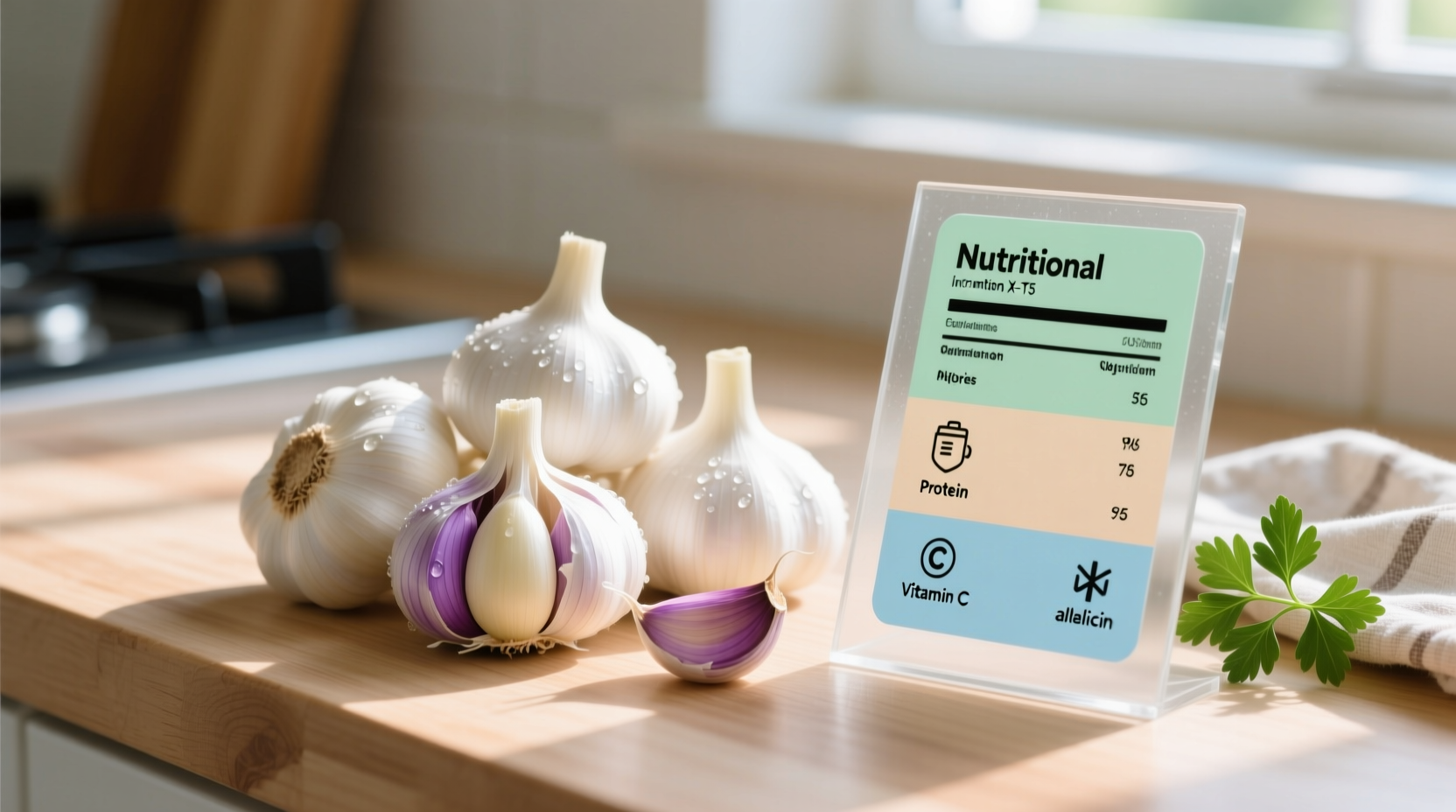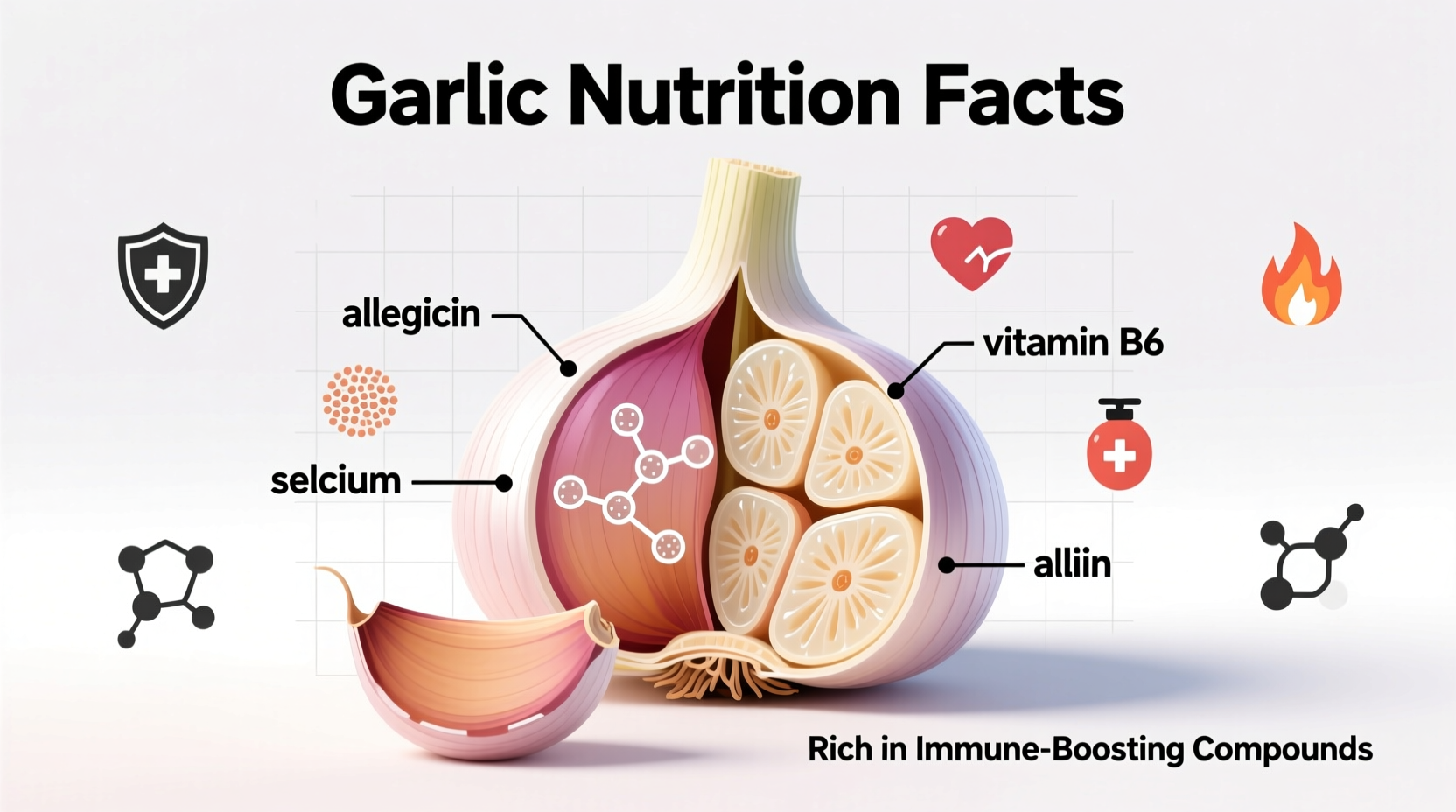One medium-sized raw garlic clove (3g) contains just 4.5 calories, 1g carbohydrates, 0.2g protein, and delivers 1.4% of your daily manganese, 1.9% of vitamin B6, and 2.3% of vitamin C needs. Most importantly, garlic contains allicin—the sulfur compound responsible for its distinctive smell and most studied health benefits—which forms when garlic is chopped or crushed.
Discover exactly how this ancient culinary staple transforms from simple kitchen ingredient to nutritional powerhouse. Whether you're a health-conscious cook or just curious about maximizing garlic's benefits, you'll learn precisely how much to use, the best preparation methods, and what science actually says about its health effects—no exaggerated claims, just evidence-based facts.
Garlic's Core Nutritional Profile: What's Really Inside
Understanding garlic's nutritional composition requires looking beyond basic vitamins and minerals to its unique bioactive compounds. While a single clove seems small, its impact is significant when consumed regularly.
| Nutrient | Per Clove (3g) | Per 100g | Daily Value % |
|---|---|---|---|
| Calories | 4.5 | 149 | 0.2% |
| Carbohydrates | 1.0g | 33.1g | 0.3% |
| Fiber | 0.1g | 2.1g | 0.4% |
| Protein | 0.2g | 6.4g | 0.4% |
| Vitamin C | 1.0mg | 31.2mg | 2.3% |
| Vitamin B6 | 0.04mg | 1.24mg | 1.9% |
| Manganese | 0.03mg | 1.67mg | 1.4% |
| Selenium | 0.3mcg | 14.2mcg | 0.5% |
Data source: USDA FoodData Central
What makes garlic nutritionally unique isn't just these standard nutrients, but its organosulfur compounds—particularly allicin, which forms when garlic is cut or crushed. This compound is responsible for most of garlic's studied health benefits but is highly unstable, breaking down quickly when exposed to heat or air.
The Science Behind Garlic's Health Benefits
Garlic's reputation as a health-promoting food spans millennia, but modern research helps separate fact from folklore. Let's examine what peer-reviewed studies actually show:
Cardiovascular Support: What Research Confirms
A comprehensive 2020 meta-analysis published in Experimental and Therapeutic Medicine reviewed 11 clinical trials involving 810 participants. The analysis confirmed that aged garlic extract significantly reduced total cholesterol by 7.2 mg/dL and LDL cholesterol by 5.9 mg/dL compared to placebo. Blood pressure reductions were also observed, particularly in those with hypertension.
"The evidence for garlic's cardiovascular benefits is among the strongest for any food compound," explains Dr. Matthew Budoff, professor of medicine at UCLA and co-author of multiple garlic studies. "Regular consumption appears to improve endothelial function and reduce arterial stiffness, which are key factors in heart health."
Immune System Modulation
Research shows garlic enhances immune cell activity. A 2012 study in Clinical Nutrition followed 146 participants through cold season. Those taking aged garlic extract had 21% fewer colds and recovered 1.5 days faster than the placebo group. The study noted increased activity of gamma delta T-cells and natural killer cells—critical components of our immune defense.
Antioxidant Properties Timeline
Garlic's antioxidant effects have been studied extensively over the past three decades:
- 1990s: Initial research identified allicin's antioxidant properties in test tubes
- Early 2000s: Studies demonstrated garlic's ability to increase glutathione levels—the body's master antioxidant
- 2010-2015: Research confirmed garlic reduces oxidative stress markers in humans with cardiovascular disease
- 2016-Present: Focus shifted to understanding how garlic compounds activate the body's own antioxidant defense systems
Maximizing Garlic's Nutritional Benefits: Practical Application Guide
Knowing garlic's nutritional profile is only half the story—you need to use it correctly to access its benefits. Here's what research shows works best:
Preparation Methods That Preserve Nutrients
The enzyme alliinase, which creates beneficial allicin, works best at room temperature after garlic has been cut:
- Crucial waiting period: After chopping or crushing, let garlic sit for 10 minutes before cooking. This allows maximum allicin formation.
- Cooking temperature matters: Keep heat below 140°F (60°C) when possible. Higher temperatures rapidly degrade allicin.
- Raw vs. cooked: Raw garlic delivers the highest allicin content, but cooked garlic still provides beneficial compounds like diallyl disulfide.

Daily Intake Recommendations
Based on clinical research, these intake levels deliver measurable benefits without excessive side effects:
- General health maintenance: 1-2 raw cloves or 2-4 cooked cloves daily
- Cardiovascular support: 600-1,200 mg of aged garlic extract (standardized) or equivalent in fresh garlic
- Immune support during cold season: 1,800 mg of aged garlic extract daily
"Consistency matters more than single large doses," notes Dr. John Milner, former chief of nutrition science at the National Cancer Institute. "Regular moderate consumption provides more sustained benefits than occasional large amounts."
Important Considerations and Limitations
While garlic offers impressive benefits, certain considerations affect who should consume it and how much:
Context Boundaries: Who Should Moderate Intake
Garlic's blood-thinning properties require caution in specific situations:
- Before surgery: Stop high-dose garlic supplements 7-10 days pre-operation due to bleeding risk (per American Society of Anesthesiologists)
- With blood thinners: Consult your doctor before consuming large amounts if taking warfarin or similar medications
- Digestive sensitivity: Those with IBS may need to limit intake as garlic is high in FODMAPs
Realistic Expectations: What Garlic Can't Do
Despite popular claims, garlic isn't a miracle cure. Research shows it works best as part of a comprehensive healthy lifestyle:
- Won't cure existing infections on its own (despite antibacterial properties)
- Provides modest cholesterol reduction compared to medications
- Effects build gradually over weeks of regular consumption
Storing Garlic to Preserve Nutritional Value
How you store garlic significantly impacts its nutrient retention:
- Whole bulbs: Store in cool, dark, well-ventilated place (not refrigerator) for up to 3 months
- Separated cloves: Last 7-10 days at room temperature
- Chopped/crushed: Maximum 24 hours refrigerated in airtight container (allicin degrades rapidly)
- Freezing: Preserves some compounds but destroys allicin-forming enzymes
"The moment garlic is damaged, its beneficial compounds begin changing," explains Dr. Eric Block, garlic chemistry expert and author of Garlic and Other Alliums. "Understanding this transformation process helps maximize benefits through proper handling."











 浙公网安备
33010002000092号
浙公网安备
33010002000092号 浙B2-20120091-4
浙B2-20120091-4